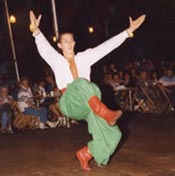home >> educational
resources >> teacher's
guide >> about
A Teacher's Guide to Folklife Resources
About This Guide
A Teacher's Guide To Folklife Resources includes a list of materials
that will be useful to educators who wish to incorporate folklife projects
and programs into their teaching, whether in classrooms, home schools,
youth groups, museums, or libraries. This online guide, edited by Carol
Moran and Catherine Hiebert Kerst, is based on the print publication, A
Teacher's Guide to Folklife Resources for K-12 Classrooms edited by
Peter Bartis and Paddy Bowman (Library of Congress, 1994). An abundance
of diverse resources is available currently, including books, pamphlets,
sound recordings, Web sites, and videos, and multimedia kits. Many of them
are listed in this guide.
Thanks to the many people around the country who provided new and updated
entries. We are grateful for the advice and "leads" on new materials,
and suggestions on how to organize and classify them. We especially want
to thank the generous people who donated copies of their work. These materials
are shelved in the American Folklife Center's Folklife Reading Room.
It is our hope that teachers, folklorists, and anyone interested will stop
in and make use of them.
We also invite you to help us to keep this guide current. To submit updates
or suggestions for new entries, please use our submission
form.
Incorporating Folklife and Community Culture
into the Curriculum
Increasingly, educators are using folklife, folk arts, and oral history--a
community's cultural heritage--to enhance education at all levels.
For decades, teachers have recognized that oral history and cultural heritage
projects that require activities both in and outside the classroom provide
stimulating ways to develop writing and communication skills, because they
require and encourage active student participation inside and outside the
classroom.
Such projects enliven, with real-world examples, the study of history,
music, art, social studies, and other topics ranging from integration to
immigration. Many items listed in this guide suggest that students and
teachers look to their own communities for provocative examples and illustrations
of classroom lessons. Some curriculum materials encourage interviews with
senior citizens, neighbors, and families; some use local music and crafts
to illustrate history and the social sciences; still others, through folk-artists-in-the-schools
programs, bring to the classroom living representatives of the cultural
traditions and heritage of their respective communities.
A Teacher's Guide to Folklife Resources will assist educators
in fostering interdisciplinary learning, cultural awareness, and stimulating
the development of original research projects and research topics in the
classroom.
To read about using folklife topics and research in the classroom see
the "What Heritage Studies Can Do For You" page of the American
Folklife Center's Explore Your Community poster. See the links
on the menu to the right for the online versions of this and other educational
materials provided by the American Folklife Center.
Acknowledgments
The Online Guide to Folklife Publications for Educators was created through
the efforts of many individuals: Carol Moran did the primary research to
update and add to the list of materials in the 1994 print edition. Matthew
Bachtell created the user-friendly database, in which the citations are
housed. Others who contributed to shaping and editing the Teacher's
Guide include Catherine Hiebert Kerst, Stephen Wesson, James Hardin,
Guha Shankar, Celina Campas, Stephanie Hall, Peter Bartis, Sarah Bradley
Leighton, and Margaret Kruesi.
|

